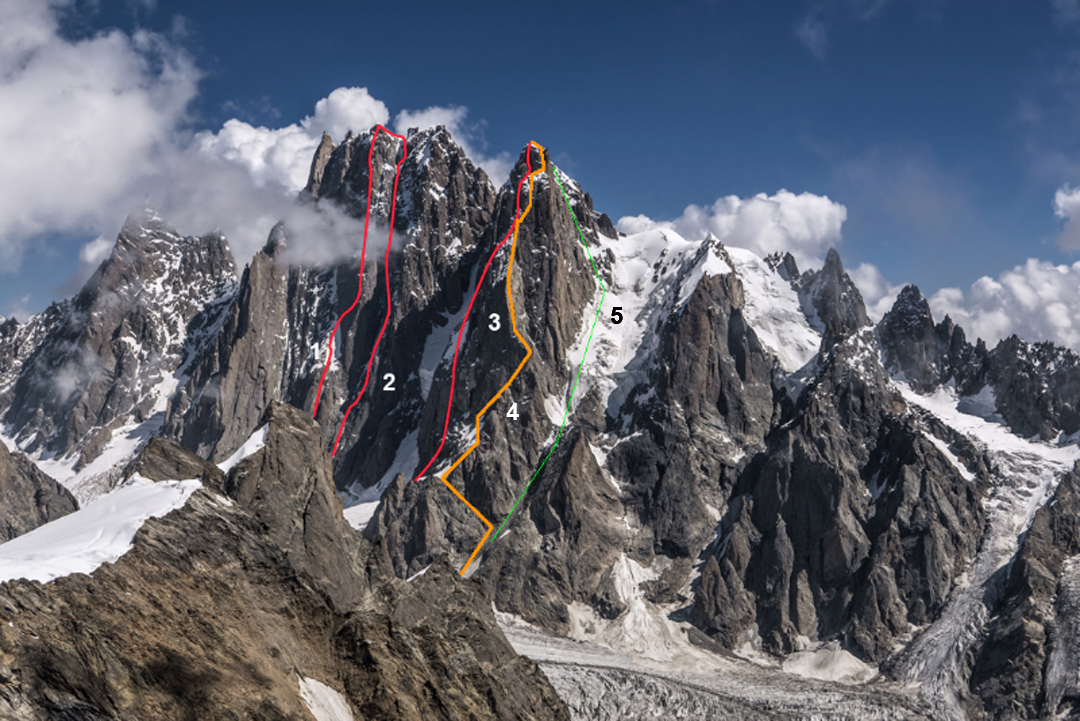Kijai Nala, Arjuna South, Southwest Pillar, Gandiva
India, Kishtwar Himalaya

Pete Graham and I have been climbing together in winter and on alpine terrain quite consistently for a few years. He was originally my mentor, but the relationship has grown into a healthy partnership, with both of us feeling able to push each other, and to make the right decisions when circumstance demands. Each year we’ve managed to push ourselves a little further on expeditions.
In January, on the suggestion of Mick Fowler, I contacted American climber Jeff Shapiro, who had climbed in Kishtwar in 2016, about Arjuna. His photos showed a steep rock spur on Arjuna South (ca 6,100m), which could prove a fantastic end to a summer of rock climbing in the U.K. We enlisted Uisdean Hawthorn and arrived in Delhi on September 12. Later that month, three days of walking through the Kijai Nala took us to base camp.
Our first glimpse of Arjuna confirmed we had made a very good choice. The rock looked excellent, and the route itself seemed free from objective dangers. However, there appeared to be blank sections high on the spur, and choosing a descent presented an intimidating problem.
We acclimatized by moving gear to a high camp at the base of the route (4,700m) and walking to 5,300m on a ridge above base camp. We then waited out a spell of bad weather at base camp until October 2, when we walked up to our advanced base and left at dawn the next day to climb a gully on the right flank of the pillar. After reaching a notch at the base of an imposing rock wall, we climbed three excellent steep pitches to the base of the arête. We had brought rock shoes for the leader and jumars for the seconds, and this proved the fastest and least stressful method of ascent. A further three pitches on lower-angled ground, which we could second in boots, brought us to a palatial bivouac.
Next morning I set off up the corner above, which proved a fantastic technical exercise with a small roof to pass at the top. I was surprised to find myself already at the blank-looking section. Here, the few cracks that we had spotted from below seemed disconnected, and it looked like we might not be able to continue. But the rock was more featured than granite tends to be, with lots of chicken heads providing face holds. Traversing around the arête, I found cracks leading to a small ledge below a menacing chimney. This was avoided by technical face climbing on lumps to access a steep hand crack, which led to another good stance near the arête. This last pitch was the rock climbing crux, though many of the pitches were only slightly easier. Above, high-quality climbing on Chamonix-style granite led to easier-angled though still complicated terrain, and at dusk we reached a small snow arête, where we spent a cold night.
 Next morning, Pete took us to the top of the pillar via a couple of excellent pitches on huge chicken heads. We rappelled into the notch on the far side and discovered an anchor from the 1983 Polish team that had climbed the west face of Arjuna South. We climbed directly up the headwall to the right of their line and made our third bivouac a little below the two “horns” that dominate the top of the mountain. After a good night's sleep we climbed the right-hand of two gullies via a hard mixed step to reach steep ice, the summit ridge, and finally the top.
Next morning, Pete took us to the top of the pillar via a couple of excellent pitches on huge chicken heads. We rappelled into the notch on the far side and discovered an anchor from the 1983 Polish team that had climbed the west face of Arjuna South. We climbed directly up the headwall to the right of their line and made our third bivouac a little below the two “horns” that dominate the top of the mountain. After a good night's sleep we climbed the right-hand of two gullies via a hard mixed step to reach steep ice, the summit ridge, and finally the top.
Basking in the late morning sun, congratulating ourselves that we'd climbed every pitch free when initially we thought aid would be necessary, we allowed ourselves to enjoy a short while on top. Before too long the prospect of descent became pressing, and we traversed to a point on the southeast face from which we could start rappelling. Pete led us bravely down the face in 12 long rappels, until we eventually reached a glacier south of the mountain, a short while after dark. We walked down this until a steepening required a further five rappels, and we stopped for the night in a notch atop the approach gully, 300m above our advanced base.
This proved a good decision, as we benefited from the cold of the next morning to descend steep, choss-covered slabs. A further four rappels brought us to the bottom, extremely satisfied to have climbed such a beautiful and imposing line on our first trip to Asia. We named the route Gandiva (1,400m, 5.11 M5).
Ben Silvestre, Alpine Club, U.K.







